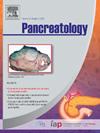用GLP-1受体激动剂治疗体重管理患者急性胰腺炎的预测因素。
IF 2.7
2区 医学
Q2 GASTROENTEROLOGY & HEPATOLOGY
引用次数: 0
摘要
胰高血糖素样肽-1受体激动剂(GLP-1RA)被广泛用于治疗肥胖和2型糖尿病(T2D)。GLP-1RA与急性胰腺炎(AP)有关,尽管数据存在争议。我们的目的是确定影响GLP-1RA治疗肥胖症后发生AP风险的因素。方法:我们进行了一项回顾性病例对照研究,包括开始使用GLP-1RA治疗肥胖的成年患者,以确定服用GLP-1RA的肥胖患者与AP相关的危险因素。我们确定了开始使用GLP-1RA的患者。使用多变量逻辑回归模型来确定GLP-1RA使用的AP预测因素。结果:共有2245例患者,其中49例(2.2%)在开始GLP-1RA治疗后发生AP。胆结石病史(调整比值比(aOR)为2.9 [95% CI, 1.6 - 5.3])、AP病史(aOR为4.8 [CI, 1.8 - 13.2])、CAD/PVD (aOR为2 [CI, 1.01 - 3.9])和吸烟(aOR为2.4 [CI, 1.2 - 4.7])与使用GLP-1RA的AP风险升高相关。与BMI≤30 kg/m2相比,BMI 36-40和bbb40与GLP-1RA治疗的AP风险降低相关(aOR分别为0.2 [CI, 0.06至0.6])和(aOR为0.25 [CI, 0.09至0.68])。结论:开始GLP-1RA治疗肥胖后,胆结石病史、AP病史、CAD/PVD病史和吸烟与AP相关。较高的BMI似乎对AP有保护作用。识别GLP-1RA启动后AP的相关因素可以告知临床医生风险分层。本文章由计算机程序翻译,如有差异,请以英文原文为准。
Predictors of acute pancreatitis in patients treated with GLP-1 receptor agonists for weight management
Introduction
Glucagon-like peptide-1 receptor agonists (GLP-1RA) are widely prescribed for treating obesity and Type 2 Diabetes (T2D). There have been concerns that GLP-1RA is associated with acute pancreatitis (AP), although the data are controversial. We aimed to identify factors that impact the risk of AP after initiation of GLP-1RA treatment for obesity.
Methods
We performed a retrospective case-control study including adults patients initiated on a GLP-1RA for obesity management to determine risk factors associated with AP in obese patients taking GLP-1RA. We identified patients initiated on GLP-1RA. A multivariable logistic regression model was used to identify predictors of AP with GLP-1RA use.
Results
There were 2245 patients, of which 49 (2.2 %) developed AP after starting a GLP-1RA. A history of gallstone disease (adjusted odds ratio (aOR), 2.9 [95 % CI, 1.6 to 5.3]), history of AP (aOR 4.8 [CI, 1.8 to 13.2]), CAD/PVD (aOR 2 [CI, 1.01 to 3.9]) and tobacco use (aOR 2.4 [CI, 1.2 to 4.7]) were associated with a higher risk of AP with GLP-1RA use. Compared to a BMI ≤30 kg/m2, BMI categories 36–40 and > 40 were associated with a lower risk of AP with GLP-1RA therapy, (aOR 0.2 [CI, 0.06 to 0.6]) and (aOR 0.25 [CI, 0.09 to 0.68]), respectively.
Conclusion
A history of gallstone disease, history of AP, CAD/PVD, and tobacco use were associated with AP after initiation of GLP-1RA for obesity treatment. A higher BMI appears to be protective against AP. Recognizing factors associated AP after GLP-1RA initiation can inform clinicians on risk stratification.
求助全文
通过发布文献求助,成功后即可免费获取论文全文。
去求助
来源期刊

Pancreatology
医学-胃肠肝病学
CiteScore
7.20
自引率
5.60%
发文量
194
审稿时长
44 days
期刊介绍:
Pancreatology is the official journal of the International Association of Pancreatology (IAP), the European Pancreatic Club (EPC) and several national societies and study groups around the world. Dedicated to the understanding and treatment of exocrine as well as endocrine pancreatic disease, this multidisciplinary periodical publishes original basic, translational and clinical pancreatic research from a range of fields including gastroenterology, oncology, surgery, pharmacology, cellular and molecular biology as well as endocrinology, immunology and epidemiology. Readers can expect to gain new insights into pancreatic physiology and into the pathogenesis, diagnosis, therapeutic approaches and prognosis of pancreatic diseases. The journal features original articles, case reports, consensus guidelines and topical, cutting edge reviews, thus representing a source of valuable, novel information for clinical and basic researchers alike.
 求助内容:
求助内容: 应助结果提醒方式:
应助结果提醒方式:


